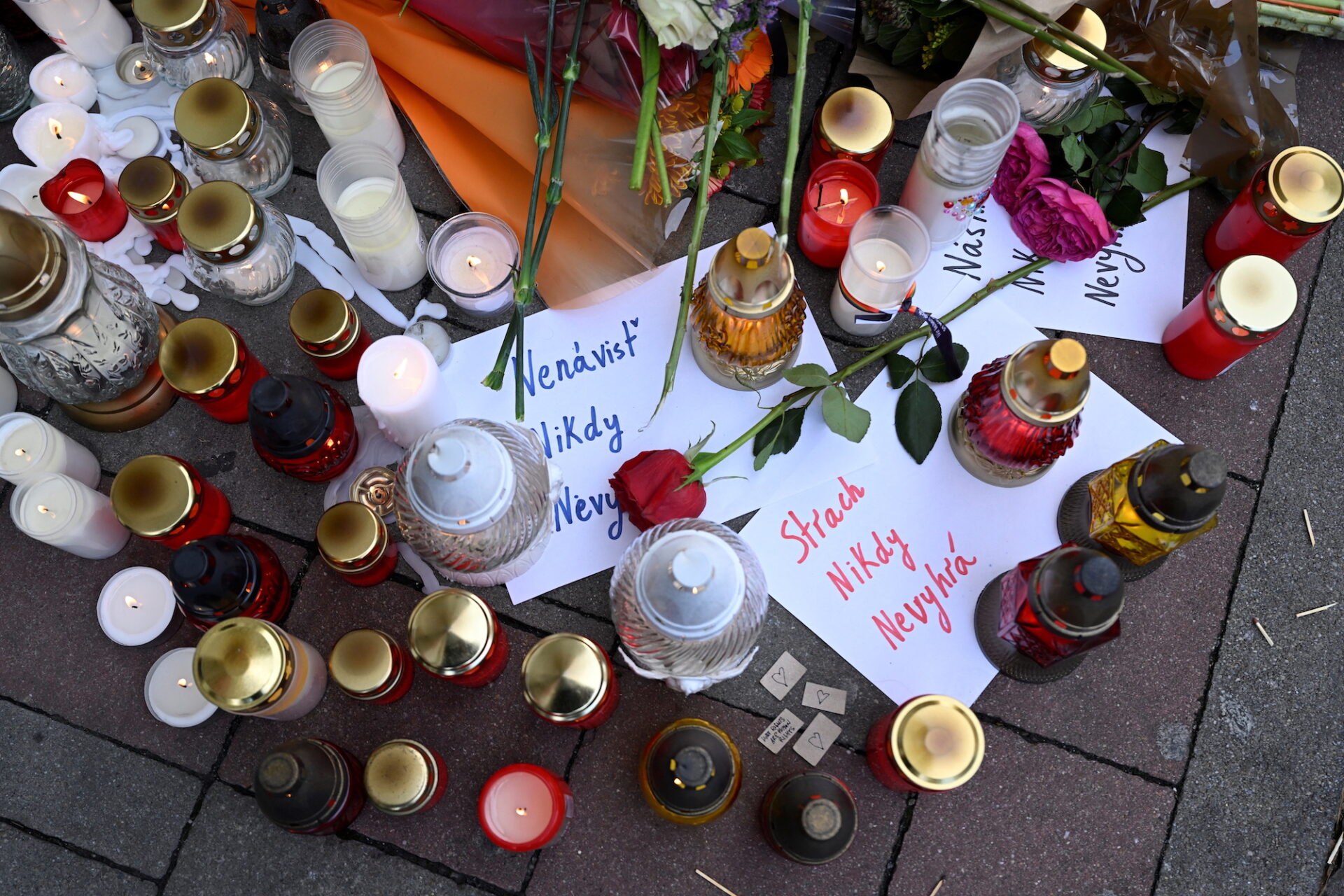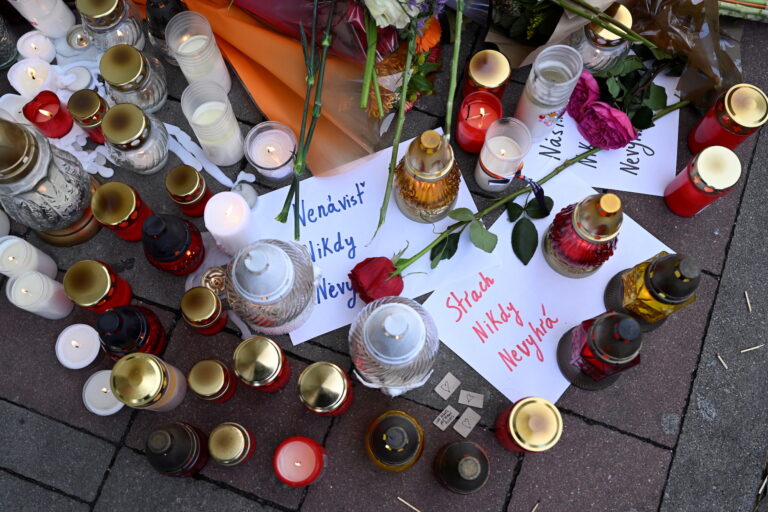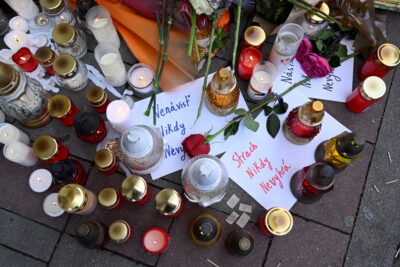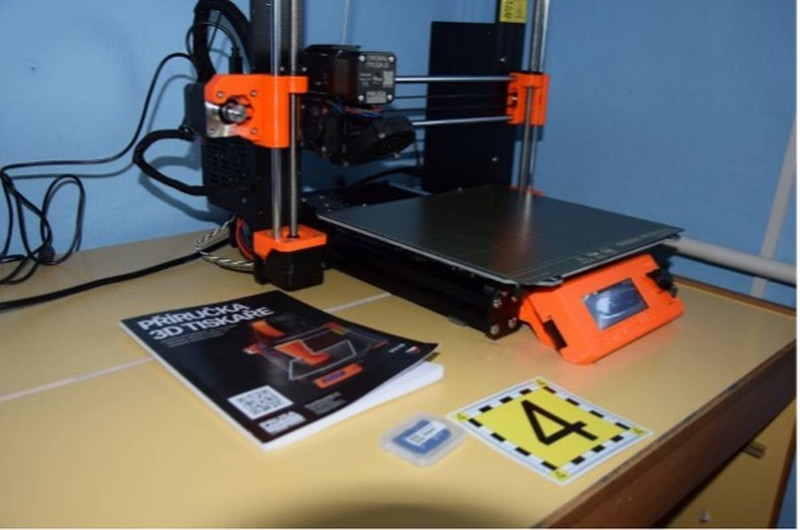by Lukáš Diko, Karin Kovary Solymos (ICJK), Aktuality.sk, Ali Winston (independent journalist), Martin Laine (Delfi Estonia)
The cold-blooded murder of Matúš Horváth and Juraj Vankulič in front of a gay bar in Bratislava began with online radicalization and hatred towards the LGBTI+ community.
The motive was confirmed after the discovery of the shooter’s Twitter account, where he was still posting while fleeing from the police, and a 60+ page manifesto. This document, written in English, is rife with white supremacy, accelerationism, and hatred.
The Ján Kuciak Investigative Centre, in cooperation with a group of foreign journalists, has obtained information that demonstrates the murderer was radicalized on Terrorgram.
The Slovak version of this article was originally published on icjk.sk
While the 19-year-old killer was fleeing from the police, he was still communicating on Twitter and the 4chan forum. A feverish debate and search for materials related to the murder in Bratislava have already been sparked on Terrogram – the far-right fringes of the Telegram platform where anonymous users from all over the world have created a network of neo-Nazi channels.
An expert on right-wing extremism, who asked to remain anonymous for his safety, monitored the first reactions from followers of Terrorgram’s channels. He notes that “they began to behave like prophets, speaking of hate and killing, and that this [killer] was their first disciple – spreading the gospel of white supremacy through violence.”
According to the expert, these right-wing extremists “were thrilled because they could state being directly responsible for [the attacker’s] radicalization, and they proclaimed him the first saint of Terrorgram.” For now, however, it is unclear whether members of the Terrogram community had known about the killer’s plans before he put them into action.
But what is certain is that they have been using the Bratislava shooting in their propaganda – shortly after the double homicide, posters featuring the killer’s likeness began circulating on Terrorgram, and then later videos. An initiative to translate the murderer’s manifesto also appeared.
American investigative journalist Ali Winston, who has long covered the radical right, describes Terrorgram as an extremely potent millennial neo-fascist propaganda network that can produce “lone wolf” terrorists. Its propaganda packages are assembled by an anonymous, dispersed group of transnational accelerationists. Mostly, he says, these are PDF files that can be hundreds of pages long or well-produced videos that push narratives of violent white resistance in the form of terrorist attacks. Members of this extremist community have endorsed and used in their propaganda, for example, the far-right extremist Anders Breivik, who murdered more than 70 people in a terrorist attack in Norway in 2011, or Brandon Tarrant, a terrorist of the same ilk (who killed 51 people in New Zealand). Many propaganda videos on Terrorgram contain footage of violence and similar mass murders perpetrated worldwide.
“Terrorgram is a key means of communication. This is supported by the fact that one 2020 publication is labeled ‘A Terrorgram Publication.’ However, the publication also calls for the establishment of groups (‘tribes’) in the real world,” explains Matej Medvecký, an expert on right-wing extremism.
Special Prosecutor Daniel Lipšic says the evidence suggests the Bratislava killer was a lone gunman. Experts say this is yet another case in which the attacker is not part of a formal group of white supremacist terrorists but an individual radicalized online. In his manifesto, the attacker thanked the Terrorgram collective. He also admitted he was inspired by the activities of a Slovak right-wing extremist from Telegram nicknamed SLOVAKBRO, who was arrested in May. While the Bratislava shooter looked up to international mass murderers as role models, according to experts, his radicalization could have also been influenced by events in Slovakia and negative attitudes towards LGBTI+ people there.
“Self-radicalization on the internet has lowered the ‘age limit’ and affected young teenagers. The plans of lone extremists are very difficult to monitor and prevent, and [are], therefore, more likely to succeed. There are examples of people radicalizing whose family background lacks any extremist views. Those who come from a family where extremist ideas and conspiracy theories have already been absorbed or where they are strongly present in their circle of friends are more vulnerable. Of course, they do not necessarily become propagators of such ideas,” says Bulcsú Hunyadi, an expert on extremism at the Political Capital think-tank.
Psychologist Marek Madro helped police track down the murderer from Zámocká Street. “Our experience with offering crisis services demonstrates that over the course of these two difficult years, when we have been faced with the extreme polarization of society, mental health has taken a serious hit, especially among young people who are at a sensitive and vulnerable age. These difficult and tragic events are the results of the escalation of long-unresolved issues and problems that piled up and grew more intense over those two years,” he says.
The murderer’s Terrogram trail
Until the terrorist attack on Zamocka Street in Bratislava, Terrorgram was an unknown online space to the Slovak public. However, on the fringes of the Telegram platform, closed channels and groups have existed for years, spreading hate against the proclaimed “enemies of the white race,” Jews, and LGBTI+ people and disseminating violent content in various forms.
In his manifesto, the Bratislava shooter dedicated a special thanks to the Terrorgram community, praising its members for their “wonderful texts, art, and for practical guides.”
According to the unnamed expert on right-wing terrorism on Telegram, “the administrators of major Telegram channels and propaganda makers said that [the killer] was part of the community and influenced by their work.” The expert shares that the killer, in his online activities, also mentioned the publications on Terrorgram that influenced him. However, whether these Terrorgram-linked channels’ administrators knew about his murderous plans remains unclear.
The content of channels and conversations on Terrorgram is essentially always the same, says the unnamed expert. “Discussions about killing, rape, and white supremacy. It’s violent and aggressive. There was no indication that anyone was going to carry out an attack, but in groups, it’s always possible,” he explains. What does happen, however, is that people discuss their intentions to carry out attacks and share bomb-making instructions or post pictures of their weapons. “Fortunately, these cases are often resolved sooner or do not progress beyond mere words,” the expert adds.
In the run-up to the Bratislava attack, a new propaganda film was expected to be released on Terrorgram. According to the expert, the trailer was already circulating on Terrogram, and it may have influenced the shooter’s decision-making. When the film was eventually released, after the attack occurred, it was dedicated to the shooter. The expert adds that such videos aim to inspire others to commit violent acts: “It shows that, look, if you do this, you will also become a saint, and we will make sure your name lives on.”
The expert describes Terrorgram’s reaction to the murder of two innocent people in Bratislava in one word – enthusiasm. “They were excited and wanted to get as much material as possible, so they could start creating more propaganda. He was the first saint of Terrorgram, one of them, influenced by their words and propaganda,” says the expert, describing the discussions on the violent network.
According to psychologist Marek Madro, who helped track down the shooter and communicated directly with him, the killer’s verbal and non-verbal communication were in stark contrast to each other after the attack. “I saw a frightened young man, who was repeating learned phrases and trying to convince us that he believes them. In reality, he was frightened and afraid,” notes Madro.
Young people, he says, often speak about how they are angry at and frustrated with adults who deal with their own frustrations and discontent by writing about them on social media and in the process pave the way for polarization, tension, hatred, and aggression, but do not come up with any effective solutions that might change or calm down the situation. “If such a situation lasts a long time or repeats cyclically, young people will, to the extent possible, take justice into their own hands with the desire and intent to make a change. If they are surrounded by an environment that supports their intentions, whether positively or negatively, their commitment to action grows. In the case of the tragic events on Zámocká Street, we can most definitely say that this environment consisted of extremist groups existing in closed groups on social media and their ideology,“ adds Madro.
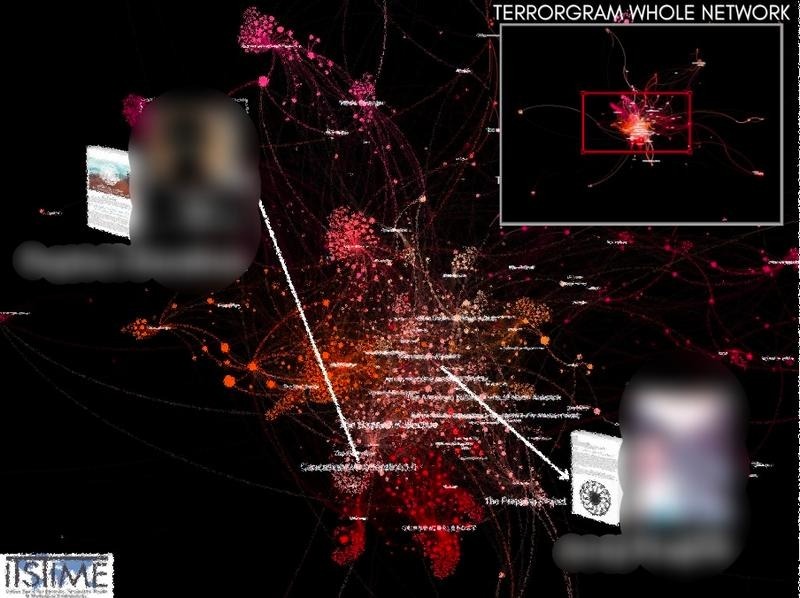
Terrorgram Social Network Analysis of the Italian Security, Terrorism and Emergency Management Team ITSTIME. Source: ITSTIME, Anonymized.
“The First Saint of Terrorgram”
Terrorgram’s propaganda proclaims white mass murderers – those who have committed attacks against the “enemies of the white race” in the name of white supremacy, neo-Nazism, or related ideologies – to be saints. Whether or not the attackers were killed or imprisoned, they are considered martyrs and become role models of sorts.
Right-wing extremists use the so-called “Calendar of Saints.” Each month, they share historical acts of violence related to white supremacism that have shaped their movement. By doing this, they hope to inspire others. The calendar also presents some “brothers” who do not claim to be white supremacists but whose violent acts, nevertheless, have been enthusiastically welcomed by extremists.
Information from Terrorgram-related channels indicates that members of this community immediately began glorifying the Tepláreň bar killer as a saint and produced large amounts of propaganda related to him. They even created a “saint poster” for him, which the ICJK had the opportunity to analyze. Its features are identical to the posters appearing in the mentioned calendar. These posters are created following a template immediately recognizable to the target audience. According to Left Coast Right Watch data, nearly 100 such posters had been created by January 2022. These propaganda materials include, among other things, the name of the perpetrator, a link to his main Terrorgram channel, the number of victims of the violent incident, and the date of the “day of action” – complete with Nazi runes and photos of the victims.
According to the unnamed expert, the Bratislava murderer’s manifesto was immediately transformed “into a gospel.” “They saved it, shared it, and spread it. They even made an audiobook out of it. They praised how he spoke about the need to kill Jews and commit acts of violence. They praised his English. Many saw it as an important manifesto with the potential for further radicalization,” says the expert, familiar with the Terrorgram environment. Incidentally, the manifesto was still available on the Internet Archive a few days after the attack. It was removed only after a request from the Counter Extremism Project.
The members of Terrorgram have also made a list of specific enemies, including lawyers, politicians, Jewish people, and others, who are identified as good targets of attacks. The entries in this list closely resemble sports trading cards.
Telegram: A haven for disinformation and terrorists
In recent years, Telegram has become one of the central channels used by conspiracy, disinformation, and extremist groups. In addition to the use of encrypted messaging, the application also allows the creation of public channels whose content is neither filtered nor curated in any way.
This is one of the reasons white supremacists have proliferated on this platform. They use it to build and organize online communities, spread propaganda, and recruit members. Followers of these channels openly support militant accelerationism, terrorism, racism and anti-Semitism.
What is militant accelerationism?
Matej Medvecký, an expert on right-wing extremism, historian at the Military Historical Institute
“Militant accelerationism is a set of tactics and strategies designed to create pressure and exacerbate latent social divisions, often through violence, and thus hasten the collapse of society. To this description from the Center for the Study of Accelerationism, I would add that this is one of the newest and most radical components of the current National Socialist movement, and the aim of militant accelerationists is to bring about the downfall of contemporary society through terrorist attacks and to create chaos out of which a new order is to emerge. In this new order, the Aryan race will rule the earth, and society will be built on racial principles and National Socialist ideology. Accelerationism draws on the ideas of the American neo-Nazis Joseph Tommasi, William Pierce, and James Mason.”
In 2021, the Institute for Strategic Dialogue (ISD), an international think-tank, exposed more than two hundred Telegram channels glorifying terrorism, calling for violence, spreading extremist ideologies, and demonizing minorities without having a formal affiliation to a specific group.
Terrorgram channels contain specific types of materials. One category is inspirational content (for example, manifestos produced by terrorists). These aim to reinforce a violent or terrorist mindset. Ideological materials seek to directly promote a violent extremist or terrorist worldview. Instructional materials are intended to instruct members on the operational aspects of terrorist activity.
ISD experts have pointed out that Terrorgram groups routinely share lengthy ideological materials, including PDF files and audio recordings of books by various ideologues and key anti-Semitic texts. The killer from Zámocká Street referred to some of the Terrorgram materials distributed by these groups.
Following the release of one of Terrorgram’s publications, in July, the Counterterrorism Group issued a warning of violent attacks in the US: “The motive behind the publication is to encourage white supremacists and anti-government individuals and groups to take violent actions against the US government which, according to them, is facilitating the replacement of the white race in the US with non-white minority groups.” The warning highlights the attackers likely use of the publication as a guide to achieve “sainthood.”
An expert on far-right terrorism on Telegram, who asked us to keep his identity secret, says these publications aim to radicalize and prepare people to commit lone-wolf-style attacks: “They talk about the importance of militant and terrorist actions. They discuss the best way to shoot and kill. They discuss strategy, whom to kill, how to do it, and where to focus. Visually speaking, they are interesting so that their contents can be disseminated both as a whole and by individual parties separately.”
“These publications are available online in PDF format, but they can also be printed and purchased in hard copy,” he says, describing distribution methods. The authors behind Terrorgram’s channels also produce audiobooks with terrorist instructions. Such channels are then credited in publications – for example, in an earlier Terrorgram publication, Slovak members were credited with a total of 133 contributions.
Investigative journalist Ali Winston, who has long covered the radical right scene, says that Terrorgram propaganda is spread mainly through Telegram channels associated with the extreme right. “Publications and videos, some of which contain bomb-making instructions disguised as Minecraft pages (a simple internet inside joke often used to mask violent sentiments or intent) or lists of potential infrastructure targets (power plants, water filtration plants, etc.), can be found online in short clips or images,” says Winston.
Although Terrorgram draws on propaganda created by other far-right terrorist organizations such as Atomwaffen Division, the Base, and Feuerkrieg Division, Millennial and Gen Z militants do not affiliate themselves with specific groups, according to Winston. Instead, they promote a “leaderless resistance” model involving small three-man cells or “lone wolf” actions. Avoiding a group label allows individual attackers to remain undetected for as long as possible until they decide to commit murderous actions.
“Much of the radicalization seems to be taking place genuinely online, and the events of recent years suggest that the period during which a person can become radicalized enough to launch an attack may not be very long at all. Besides manifestos, violence-promoting memes also play a role in radicalization. The same goes for the glorification of perpetrators and the streaming of attacks – it all contributes to the adoption of role models,” adds right-wing extremism expert Matej Medvecký.
A private Twitter account and farewell manifesto
The Bratislava murderer confessed to the crime online shortly after the attack. Earlier, in one of his tweets, he wrote that he had “decided” and that “it will be done.” Shortly after the shooting, he boasted of his attack and claimed he did not regret his actions. Police found his body the next morning. By all accounts, he had committed suicide.
His links to the Terrorgram community are also suggested by several posts from a Twitter account he set up in April 2021. Until the attack, his profile was non-public. Our analysis found that the Slovak terrorist wrote a number of hateful tweets against LGBTI+ people and the Jewish community.
In his tweets, he mentioned right-wing mass murderers such as Brenton Tarrant, Payton Gendron, and Anders Breivik as his role models. In his manifesto and tweets, he referred to the New Zealand mass murderer in Terrorgram terminology, calling him a “saint.” He also wrote that Tarrant’s actions inspired him to take an interest in the anonymous communication platform 8chan. “At the time, I had not yet been fully redpilled,” he wrote in his pamphlet.
He embarked on the path of radicalization in early 2019. He made the final decision to carry out the attack in May 2022. In May, a radicalized teenager murdered ten people in a supermarket in Buffalo, USA. It was also in May 2022 that Slovak police arrested a Slovak extremist called SLOVAKBRO, whom the killer described as one of his role models.
On 28 May, he posted a pill emoji on Twitter, presumably referring to the completion of the so-called redpilling process.
Redpilling, also known as “taking the red pill,” is a reference to the movie The Matrix, in which the main character takes the red pill to learn the truth about his society. The red pill is a kind of gateway into the conspiracy thinking that drives much of the radical right’s violent extremism.
In his tweets, he repeatedly hinted at plans to carry out a mass act of violence. In September, he published a series of posts referring to a violent “operation.” He wrote that people should not carry out such acts unless they are prepared to take another person’s life. A few days later, he wrote about an impending “race war.”
The location of his attack was decided in August, as indicated by photos taken outside the LGBTI+ bar Tepláreň shared on Twitter. LGBTI+ people though were not his only target. According to Special Prosecutor Daniel Lipšic, the killer’s notebook also contained the names of several well-known figures. In addition to Prime Minister Eduard Heger, whom the radical mentioned on his Twitter account, the list included political scientist Grigori Mesežnikov, former education minister Branislav Gröhling, chairman of the Smer political party Robert Fico, and a rabbi. He considered all of them traitors.
According to publicly available information, the murderer only scoped out the terrain in the vicinity of Prime Minister Heger’s residence. On Twitter, he shared photos of himself in front of the PM’s apartment building (the account was still private at that time). On the day of the attack, he waited for the prime minister in front of his apartment building in Bratislava’s Dúbravka district for several hours without being registered by police officers from the Office for the Protection of Constitutional Officers.
Influenced by his father?
One of the initial pieces of information about the shooter was that his father was a candidate for the Vlasť party. The party’s leaders, especially its most prominent face, former justice minister Stefan Harabin, are known for spreading various conspiracy theories, such as those about COVID-19, and pro-Russian narratives. The shooter’s father is no exception. That is why to some commentators his views may have influenced his son.
Among the father’s Facebook posts, we find some that strongly criticized or outright mocked Prime Minister Heger, whom his son planned to attack. However, his father’s posts mostly spread disinformation related to the COVID-19 pandemic and vaccines.
According to available posts, the shooter’s father did not address the topics covered by his son on Twitter or in his manifesto. It cannot be excluded, though, that problematic posts related to the LGBTQI+ or Jewish communities were deleted from Facebook. The shooter’s father has also written several times about being blocked from the platform or having his posts deleted.
Inspiration from Slovak extremist SLOVAKBRO
The investigation so far suggests that the Bratislava killer was a lone gunman. He was radicalized on Terrorgram but was also influenced by the activities of the Slovak extremist SLOVAKBRO, arrested by the Slovak police in May, thanks to the help of the Czech police, Slovak military intelligence, Europol, Eurojust, and the FBI.
According to Europol, the 22-year-old Slovak extremist was known in the international radical right online space. He was “linked to groups and individuals spreading neo-Nazi, far-right and white supremacist propaganda and was part of the so-called extremist Siege movement.”
He was not, however, involved in “just” the online promotion of extremist ideology. Slovakbro who was a university student in Brno, also distributed instructions and designs for producing improvised homemade automatic firearms, explosives, and mines, and instructions for sabotage attacks. During raids, Czech police also found a sophisticated 3D printer in his possession.
The Bratislava shooter praised Slovakbro, calling him one of the first extremists he encountered on Telegram.
According to the May 2022 detention order made available to the ICJK by the Specialized Criminal Court, the 22-year-old Slovakbro was an active member of Telegram channels and espoused militant accelerationism. According to open-source research on far-right extremism, he was not just a simple member of the Terrorgram community; he also managed at least one Slovak channel as early as 2019. The channel was large but is now inactive, according to a source familiar with the Terrogram environment.
The detention order in the Slovakbro case also includes posts published on Terrorgram, which, from at least January 2021 to February 2022, were intended to incite “the overthrow of the democratic political system through carrying out subversive and sabotage activities and acts of terrorism,” praising and glorifying “white” terrorists,and publishing instructions and diagrams for the production of improvised edged weapons, instructions for the home production of firearms and explosives, and instructions for sabotage attacks on critical infrastructure to cause chaos.
In his posts, he espoused neo-Nazism. He quoted Adolf Hitler’s Mein Kampf, referred to the number 1488, and directly used Nazi swastikas in his texts. He called for Holocaust denial and the “destruction of Israel.” The student eventually confessed to his crimes and is expecting to make a plea bargain. He is accused of engaging in terrorism, disseminating extremist material, and sympathizing with a movement aimed at suppressing fundamental rights and freedoms. He faces a sentence of up to fifteen years.
A week after the attack on Zámocká Street in Bratislava, Slovak police informed the public about another similar case. Officers from the National Criminal Agency detained a self-radicalized 16-year-old student from Bratislava during a police operation codenamed BALERION. According to the charges, he was distributing extremist materials and instructions for making a firearm on a 3D printer. The police confirmed that his detention was related to the Slovakbro case. After his arrest, he confessed in full and began to cooperate. “He provided access to his communication accounts, including passwords, and also handed over his unlocked mobile phone,” the judge said.
Accelerationism is directly mentioned in the court’s decision not to take him into custody. According to the judge, the actions of the accused young man “suggest that he is already gradually moving from spreading sabotage ideas (typical of the idea of accelerationism) in the online space to actually carrying them out.”
Whether these confessions are efforts to avoid heavy penalties or just a tactic is impossible to assess. An expert on the extremist right on Telegram points out that there may also be indirect instructions or “recommendations” on how to behave if a member of the Terrorgram community is detained. If they “survive,” the hate community will start creating memes. “They become kind of idols,” he adds.
Another expert on radicalization and extremism, Bulcsú Hunyadi, says radicalization is difficult to reverse, and the focus needs to be on prevention: “For deradicalization to be successful, many factors need to come together. The first condition is that the radicalized person must change and become disgusted with extremist ideas and/or his community. It takes a long time and a lot of work before a person is able to break out of the community and the system of ideas.”
Psychologist Marek Madro adds that no one is born a violent extremist and radical. “It is a process in which a person accepts an ideology and convictions. Right now we are in a situation where we are looking for solutions. In an ideal world we should be preventing this from happening. This is a challenge for us all, as individuals and society as a whole.” Madro claims that radicalism and extremism are phenomena that change and evolve alongside society, that it is our job to ensure that they do not change faster than society, and that “it is imperative that we become an inclusive society where we tackle the causes, protect those who are at risk, create opportunities for deradicalization, and when we see radicalization, not remain silent.”
Young teenagers in the ranks of Terrogram
The Bratislava shooter, Slovakbro, and a high school student from Bratislava got their hands on the contents of Terrorgram at a relatively young age. The youngest case is the latter, who, according to the order on the prosecutor’s motion to take the accused into custody, has been “established in the community of the alternative far right since 2019” – that is, since he was 13 years old.
However, these may not be isolated cases of people in their early teens radicalized in Telegram groups. In January 2020, the Estonian Internal Security Service terminated the activities of the founder and leader of the international Nazi terrorist organization Feuerkrieg Division (FKD), which described itself as an organizational arm of the US-based Atomwaffen movement.
The arrests were related to planned terrorist acts in Latvia and England. In October 2019, the FKD claimed responsibility for bombing the Western Union office on Balčikonis Street in Vilnius, Lithuania.
To the surprise of FKD members themselves, the leader of the group, whom they knew by his nickname, Commander, turned out to be a 13-year-old child living in a small town in Estonia. Because he was so young, he was not even criminally responsible for his actions.
In 2021, a Commander copycat appeared on several Telegram channels and began reforming the FKD movement under the same moniker, gaining more and more followers; in October 2021, he was arrested for threatening the public, according to Eesti Päevaleht, an Estonian newspaper. The new Commander was also from Estonia. The police did not disclose his exact age, but stated that he was a minor.
According to an expert on right-wing terrorism on Telegram, while teenagers are the targets of a vast amount of “redpilling” propaganda, it also targets older conservatives. The expert points out that “it is only after a prolonged period of radicalization that people get into the darkest areas of Terrorgram. The process usually starts with little jokes and memes.”
However, the recruitment of new members is not carried out in a targeted manner. “Propaganda is rather spread in the hope of radicalizing someone. As long as they are white and hate Jews and are influenced by this mentality, they fit into the Terrorgram community,” the expert adds.
American journalist Ali Winston points out that Terrorgram’s far right propaganda aimed at youth is “highly stylized, aesthetically appealing, and has enough cross-pollination with anti-cop, anti-state, and pro-environmental sentiment to draw people from Far Left ideologies as well as more conservative-minded folks.”
According to psychologist Marek Madro, young people are in a challenging period in their lives in terms of developmental psychology, which is accompanied by many changes: “They do not yet have enough life experience to cope with difficult situations, to assess and evaluate the risk of the situations and actions they are entering into, which is why they often tend towards extreme and radical solutions. The peer group and the desire to belong and to be accepted play an important role in their lives at this time. If this need is not fulfilled in a healthy and balanced way in their natural environment, they look elsewhere for its fulfillment, often in the online space, which provides instant gratification.”
How can online radicalization be countered? “The best way is by noticing the small signs that a person is becoming radicalized, that their thinking, behavior, dress, social life and relationships are changing. It requires a lot of listening and community work,” says Bulcsú Hunyadi. He highlights that it is necessary for classmates, teachers, parents, school psychologists, general practitioners, and other professionals who come into contact with young people to know the process, the dangers, and the signs. “Of course, we can try to block it technically by blocking platforms and taking away tools, but that won’t solve the underlying problem.”
“Young people need to create space and opportunities for conversation. They don’t want a monologue in which someone dictates to them what they should and shouldn’t do, what would happen to them if they did this or that,” adds psychologist Marek Madro, who thinks silence and ignoring the situation is even worse. “We won’t talk about it because it doesn’t concern us. On the contrary, they need an open and respectful dialogue. Let’s create a safe dialogue for them. In many situations they have questions that they need to have answered […] If we don’t give [the answers] to them, someone else will, and there is no guarantee what [these answers] will be and how it will affect them. Get their opinion, discuss what they would do and how they would do it, show your feelings. Listen to what your children are saying and avoid judging and belittling their feelings. Acknowledge the pressure, tell them where help is and encourage them to seek it. Be a safety net for them and reassure them that you will stand by them even when they make a mistake,” concludes psychologist Madro.
We consulted the text of this investigation with psychologist Marek Madro, whose comments are included. However, the psychologist also warns that if the text makes you feel uncomfortable, scared, and worried, do not be afraid to share your feelings with mental health professionals.
Cover photo: Tributes and slogans ‘Hate will never win’ and ‘Fear will never win’ are seen at the site of a shooting in Bratislava, Slovakia October 13, 2022. Source: RADOVAN STOKLASA / Reuters / Forum
 Support independent investigative journalism in Slovakia,
Support independent investigative journalism in Slovakia,
you can donate here.

